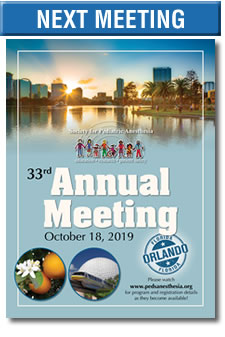SPA Meeting Reviews
Saturday Session V: The Anesthesia Workforce: Gender, Race, and Equity
Reviewed by Nancy S. Hagerman, MD
Cincinnati Children’s Hospital Medical Center
 |
Dr. Hagerman |
Gender Inequities in Our Profession: A Panel on Promotion, Pay and Power
The fifth session of Saturday gathered Jamie M. Schwartz, MD (Johns Hopkins), Nina Deutsch, MD (Children’s National Medical Center), and Jennifer K. Lee, MD (Johns Hopkins) to discuss gender inequities in pediatric anesthesia.
Dr. Schwartz began the panel discussion with a talk entitled, “Women at Work: Challenges We See and Those We Can’t” in which she described the experience of professional women in our society. Dr. Schwartz showed that although women attain 50% of college degrees, they have less leadership positions than men.
For example, men outnumber women in the U.S. Senate by 2:1 and <5% of Fortune 500 Companies have female CEOs. She went on to note that when examining millennials, women have earned 90% of men’s salaries when entering the work force, 73% of their salaries in mid-career, and are projected to earn 60% of their salaries at the end of their career. She noted differences in how children are raised in the U.S. with girls performing more chores than boys for less pay.
In the workforce, a review of 81,000 performance evaluations (DG Smith et al 2018) revealed that managers use more positive words to describe men and more negative words to describe women. The Harvard Business Review demonstrated that women are perceived differently than men when they ask for things in the workplace. For example, when using a transcript to ask for more flexibility at work to have more time for childcare, 70% of men were granted the request and were considered “likeable” and “committed” as compared to 57% of women’s requests.
A study by VL Brescoll et al had volunteer evaluators watch videos of job interviews in which applicants demonstrated anger and sadness. When controlling for appearance, age, education, dress, and ethnicity angry men were viewed most favorably, followed by sad men, then sad women, and angry women were considered least favorable. Angry men were considered to have “situational” anger whereas the women were considered to be “out of control” and “emotional.” Dr. Schwartz concluded that both women and men can have an unconscious bias in their hiring and promotion practices in favor of men, but this can be overcome.
Dr. Deutsch continued the discussion with a talk called “The Gender Gap in Medicine: Where Are We?” Although Medical School admissions have been 50/50 when comparing men to women, the majority of women graduates pursue careers in “softer specialties” such as pediatrics and GYN. In 2016, 35% of anesthesiology trainees were women. While case-loads and case distributions are similar in residency, women tend to subspecialize more in OB- and Pediatric Anesthesia. Male anesthesiologists tend to work more hours per week (57 v. 51) but women perform more clinical hours on a weekly basis (49 v. 45).
An examination of Academic Anesthesia reveals women comprise 53% of Instructors, 36% Assistant Professor, 29% Associate Professor, and 18% Full Professor (AAMC Faculty Roster, 2015). Men are also more likely to attain senior leadership positions in Academic Anesthesia when adjusted for race, seniority, and medical status as published in Academic Medicine 2018. The vast majority of department chairs are men, but a Pediatric Anesthesia Leadership Council (PALC) survey demonstrates that Pediatric Anesthesiology is a bit more egalitarian with 22 females and 41 males serving as Division Directors or Chiefs. Female physicians earn $0.90 on the $1 compared to their male counterparts on average, but not all specialties demonstrate this difference. In Anesthesiology specifically, women earn an hourly rate 11% less than men as was published in Anesthesiology November 2015.
Dr. Deutsch concluded her presentation by advocating a call to action to develop strategies to overcome barriers in the path to leadership on both an institutional and individual level.
Dr. Lee then presented the initiation of the WELI (Women’s Empowerment and Leadership Initiative) Program. The mission of the WELI program is “to empower highly productive women to achieve promotion, leadership, and equity in pediatric anesthesiology.” The program is currently in Pilot Phase 1 with 38 nominated coaches from across the country and 39 coachees/mentees. Forty-seven percent of the coaches are men. Dr. Lee explained the difference between mentoring and coaching. Mentoring involves the sharing of skills and knowledge, giving direction and advice, and is often task oriented. A coach is someone who listens, asks probing questions, increases self awareness, and helps his/her mentee explore different routes to reach her destination.
Each Coach/Mentee pair in the WELI program are encouraged to communicate at least monthly, and two workshops per year are offered to both the coaches and the mentees. Thus far, the mentees have responded favorably when asked if they are having meaningful interactions and they have reported that the program is either meeting or exceeding their expectations. The coaches also have responded that the program is meeting their expectations. The mentees have been asked to report on characteristics of themselves and next steps will include work on improving how to build trust as a leader, to think innovatively, and to appropriately manage and not micromanage.
The first Mentee Workshop was held on Friday, March 15, and topics presented included transformative leadership, how to delegate, time management, how to give feedback in tough conversations, and determining team missions and visions. The Coaches attended a workshop Saturday afternoon in which they discussed coaching and delegation skills. Dr. Lee concluded with stating that the WELI program is gratefully accepting donations (tax deductible) to further this cause within our subspecialty.
Implicit Bias in the Clinical Learning Environment
The second part of the session featured Nana E. Coleman, MD, EdM (Texas Children’s, Houston) who discussed the impact that implicit bias has in the clinical setting on learners, teachers, and patients. Dr. Coleman began her discussion by reminding us that we are all influenced by our experiences and our cultures. Implicit bias is the attitudes or stereotypes that affect our understanding, actions, and decisions in an unconscious manner. By increasing awareness of it, we can begin to minimize its influence. It is important that we are educated about this as recent (2019) ACGME requirements state that programs must provide a professional, equitable, respectful, and civil environment for students, residents, faculty, and staff.
Q Capers et al 2017 found an inherent bias for white men in one medical school’s admissions committee. Encouragingly, they also found that training can reveal and help us overlook our biases. Turrentine et al 2019 examined the influence of gender on Surgical Residency Applicant’s Letters of Recommendation. They showed that letters describing male applicants tended to have longer word counts and used more achievement and standout adjectives. Letters describing women applicants used more positive general terms and caring words.
So what can we do to mitigate implicit bias? Dr. Coleman points out that formal diversity training does not impact students’ implicit bias over time. She advocates that we recognize how stress can activate bias and influence our decisions. Recommended tools to diminish implicit bias include actively looking at our patients as individuals instead of members of a group, helping our patients become more involved in their care, and fostering a sense of being on the same team with our patients and their families. We must recognize that we all have bias, and in doing this we lessen its influence.






